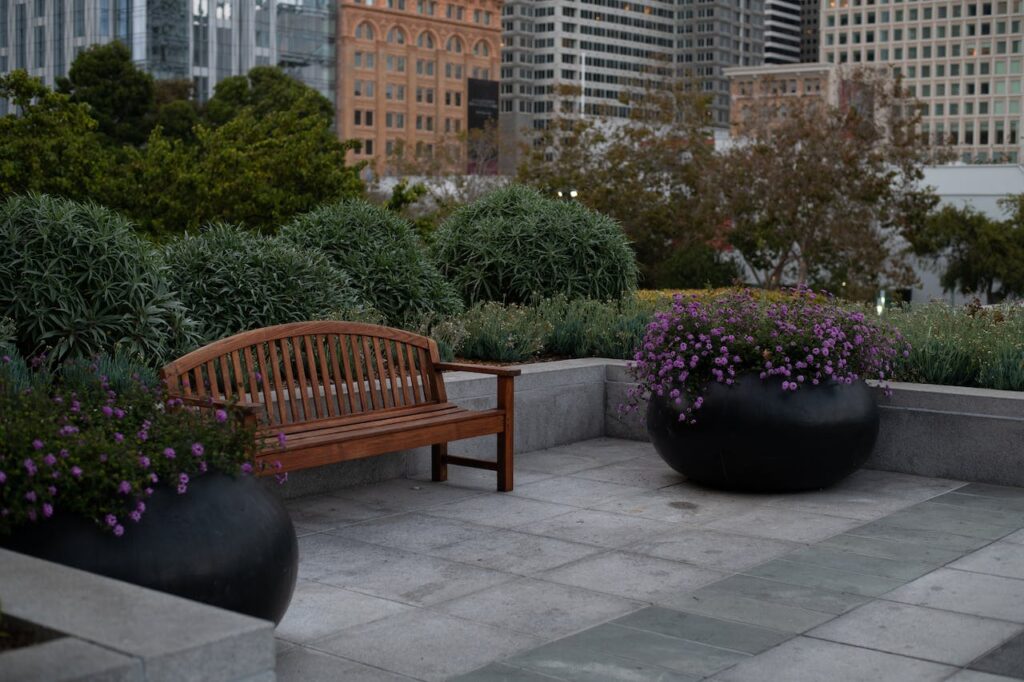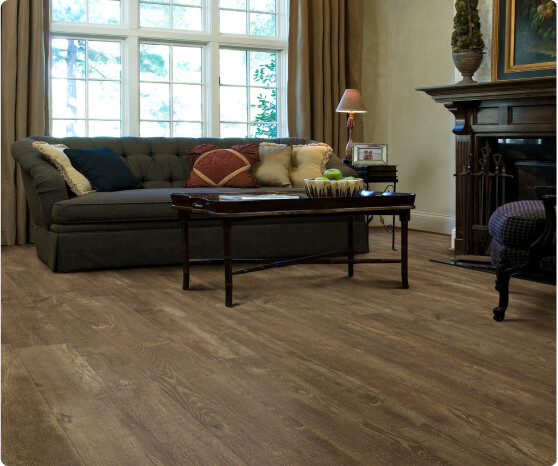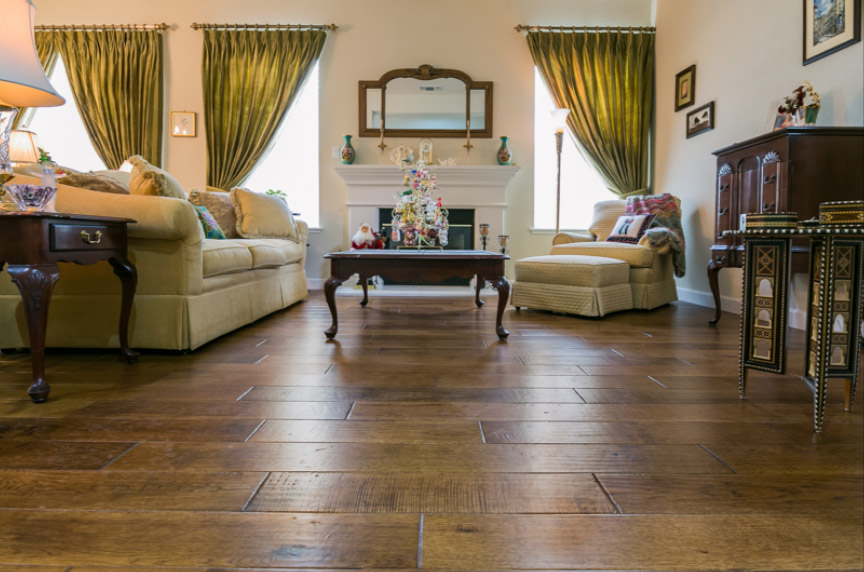Natural stone tiles are a go-to choice for outdoor patios and courtyard, prized for their enduring quality and timeless allure as perfect material. The right selection can elevate your outdoor space, creating an inviting ambiance for patio use and garden elegance. This comprehensive guide is your compass through the myriad of options, empowering you to make informed choices about various colours, elegance, and cost. From travertine tiles to concrete slabs, we’ll navigate the nuances of quality stone suitable for various outside areas such as pool surroundings or an outdoor fireplace. Understanding certain stones’ characteristics will enable you to transform your outdoor area, including patios and courtyards, into a captivating oasis that seamlessly blends durability with aesthetic charm.
Table of Contents
ToggleAssessing Location, Climate, And Light Exposure
Location And Climate
When selecting natural stone tiles for your outdoor patio, it’s crucial to consider the location and water of your patio. The type of outdoor natural stone tile you choose for outdoor flooring should be able to withstand climates. For instance, if you live in an area with hot climates, you’ll want to opt for outdoor tiles that can endure high temperatures without deteriorating. On the other hand, if your outdoor area or patios experience frequent rain or snowfall, you’ll need outdoor tiles that are resistant to moisture and won’t become slippery when wet.
Understanding the specific environmental factors of your patio’s location, such as climates, will ensure that you select the most suitable natural stone tiles. Some outdoor tiles may be more prone to cracking in certain climates or may require regular sealing to protect outdoor tile flooring from harsh weather conditions.
Light Exposure Consideration
Another important aspect when choosing natural stone tiles for your outdoor patio or courtyard is evaluating the amount of sunlight it receives. The exposure to natural light plays a significant role in determining which type of stone would be best suited for your patio. Excessive sunlight can cause some types of natural stones used for outdoor tiles in patios and courtyards in different climates to fade over time or even change color.
For example, if your patio receives direct sunlight throughout most of the day, selecting the best outdoor tiles might not be ideal as they could discolor due to sun exposure. Conversely, darker granites or slates are the best choices for outdoor tiles in a courtyard with intense sunlight since they are less likely to fade or show signs of discoloration.
By carefully assessing these factors—location, climate, and light exposure—you can make an informed decision about which type of natural stone tile will best thrive on your outdoor patio while enhancing its aesthetic appeal.
Understanding Different Types Of Natural Stone Tiles
Various Types
There are several options available, including granite, limestone, travertine, slate, and outdoor tiles. Each type of outdoor tiles has its own unique characteristics in terms of color and texture. Granite tile is known for its durability and resistance to heat, making it an ideal choice for outdoor use. Limestone offers a classic look with warm earthy tones, while travertine features a porous surface that provides natural traction for outdoor tiles.
Slate outdoor tiles are another popular option due to their slip-resistant nature and ability to withstand harsh weather conditions. By understanding the differences between these types of natural stones and tile, you can choose the one that best complements your outdoor patio based on your specific requirements.
It’s crucial to consider factors such as the climate in your area and the amount of foot traffic the patio will endure when selecting the perfect natural stone tiles for your outdoor space.
Unique Characteristics
Each type of natural stone tile, including outdoor tiles, possesses distinct qualities that make them suitable for different environments. For instance, if you live in an area with hot summers or cold winters, granite outdoor tiles would be an excellent choice due to its heat resistance and durability. On the other hand, if you prioritize aesthetics and prefer a more rustic appearance for your patio, slate outdoor tiles might be the ideal option because of its unique color variations and slip-resistant surface.
Understanding these unique characteristics of outdoor tiles will enable you to make an informed decision based on what matters most to you—whether it’s longevity, visual appeal, or practicality. By taking into account how each type of outdoor tiles aligns with factors like light exposure and climate conditions discussed earlier in assessing location suitability; you can narrow down your choices effectively.
Evaluating Durability And Weather Resistance
Choosing The Right Stone
When selecting natural stone tiles for your outdoor patio, it’s crucial to prioritize durability and weather resistance. Look for outdoor stones that are specifically recommended for outdoor use. For instance, granite tile and slate tile are known for their exceptional ability to withstand various weather conditions, making them ideal choices for outdoor applications.
It’s essential to consider factors like freeze-thaw cycles, moisture resistance, and resistance to cracking when evaluating the suitability of natural stone tiles. Some regions experience freezing temperatures during winter followed by thawing in spring, affecting outdoor tiles. This cycle can cause certain types of stone tiles to crack or deteriorate over time. Therefore, choosing a stone tile with high resistance to freezing temperatures is vital.
Long-Term Beauty And Integrity
By opting for a durable natural stone tile with excellent weather resistance properties, you ensure that your outdoor patio remains beautiful and intact for years to come. Stones with low water penetration rates also provide added protection against damage caused by moisture exposure. Some stones may require sealing to enhance their durability further.
For example:
- Granite: Known for its exceptional strength and resilience against harsh elements.
- Slate: Offers great heat resistance along with an attractive range of colors.
- Sandstone: Provides a natural look and feel while being relatively easy to use.

Safety And Slip Resistance Considerations
Slip-Resistant Surfaces
When selecting the perfect natural stone tiles for your outdoor patio, it’s crucial to prioritize safety. Opt for stones with slip-resistant surfaces to minimize the risk of accidents caused by slips and falls. Choose a material that offers traction even when wet, ensuring safety for your family and guests.
Natural stones like granite, slate, and sandstone are excellent choices due to their naturally rough textures that provide better grip underfoot. These materials can effectively reduce the chances of slipping, especially in areas with high foot traffic such as outdoor patios.
Industry Standard Ratings
To determine the slip resistance of different natural stone tiles, it’s essential to check for industry-standard ratings such as COF (Coefficient of Friction). This rating indicates how much force is required to move an object across a surface. The higher the COF value, the more slip-resistant the tile is considered to be.
For instance:
- Granite typically has a high COF due to its coarse texture.
- Sandstone also offers good slip resistance because of its grainy surface.
- Slate provides excellent traction thanks to its naturally uneven structure.
Prioritizing safety through slip-resistant natural stone tiles ensures that your outdoor patio remains a secure space for leisure activities without posing unnecessary risks.
Aesthetic Design And Finish Options
Complementing Your Patio Design
When selecting natural stone tiles for your outdoor patio, it’s crucial to consider the aesthetic appeal they bring. With a wide range of colors, patterns, and finishes available, you have the opportunity to enhance the visual appeal of your outdoor space. To ensure that the chosen stone complements your patio’s overall design theme, take into account the existing elements such as furniture, landscaping features, and architectural style. For instance, if you have a modern-themed patio with sleek lines and minimalistic furniture, you might opt for natural stone tiles with clean-cut edges and a polished finish to match this contemporary aesthetic.
It’s essential to create a cohesive look by choosing stones that work harmoniously with other design elements in your outdoor space. By doing so, you can achieve an elegant and visually appealing patio area where every aspect seamlessly ties together.
Exploring Finish Options
Exploring various finishes is vital when aiming to select the perfect natural stone tiles for your outdoor patio. Different finishes such as polished, honed, or textured offer distinctive visual and tactile experiences. For example:
- Polished Finish: If you desire a luxurious and glossy appearance for your patio flooring that reflects light beautifully while offering easy maintenance.
- Honed Finish: Opting for this finish provides a smooth yet matte surface suitable for creating a more relaxed ambiance in your outdoor space.
- Textured Finish: Choosing textured natural stone tiles can add depth and visual interest while providing enhanced slip resistance—an important consideration discussed in our previous section on safety.
Matching Tiles With Home Style And Patio Design
Consider Architectural Style
When selecting natural stone tiles for your outdoor patio, it’s crucial to consider the architectural style of your home. For instance, if you have a modern house with clean lines and minimalistic features, opting for sleek and uniform tiles like slate or granite can complement the contemporary aesthetic. On the other hand, if you reside in a rustic farmhouse-style home, rugged stone tiles such as travertine or flagstone would be more suitable. By aligning the patio tiles with your home’s architectural style, you can create a seamless transition from indoor to outdoor living spaces.
Harmonize Design Elements
In addition to considering the architectural style of your home, it’s essential to ensure that the chosen tiles harmonize with existing design elements in your outdoor space. If your garden features vibrant flowers and lush greenery, earthy-toned natural stone such as sandstone can blend seamlessly into this setting. Conversely, for a more urban courtyard setting surrounded by concrete walls and metal accents, darker colored tiles like basalt or bluestone could provide an elegant contrast. Coordinating the selection of natural stone tiles with various design elements will unify different aspects of your outdoor space.
Budgeting And Long-Term Value Considerations
Determine Budget
When selecting natural stone tiles for your outdoor patio, it’s crucial to establish a clear budget. Start by assessing how much you’re willing to spend on the project. By doing so, you can focus on exploring natural stone tile options that fall within your financial constraints.
Consider various types of natural stone tiles such as slate, limestone, or travertine and compare their prices. This will help you identify which type of natural stone fits well within your budget while still offering the aesthetic appeal and durability you desire for your outdoor space.
Once you have a specific budget in mind, visit different suppliers or browse online to find cost-effective solutions that meet both your design preferences and financial boundaries.
Long-Term Value Assessment
In addition to setting a budget, it’s equally important to consider the long-term value of the natural stone tiles for your outdoor patio. Evaluate factors such as durability, maintenance requirements, and lifespan when making this assessment.
For example, if you live in an area with harsh weather conditions or high foot traffic on the patio area, prioritize durable natural stones like granite or quartzite that can withstand these challenges over time without losing their appeal.
Furthermore, think about maintenance needs; some natural stones may require regular sealing while others are more resistant to stains and erosion. Understanding these differences is essential in ensuring that the chosen natural stone tiles align with both your short-term affordability goals and long-term value expectations.
Balancing Your Choices Ultimately, finding the perfect natural stone tiles for an outdoor patio involves striking a balance between staying within budget limitations while maximizing long-term value. For instance:
- A homeowner might opt for slightly pricier but highly durable granite tiles due to their minimal upkeep costs over time.
- Another individual might choose less expensive sandstone tiles but invest in additional sealants or coatings to enhance their longevity.
Maintenance Requirements For Lasting Beauty
Understanding Different Needs
Different natural stone tiles have varying maintenance needs to ensure their longevity and timeless appeal. For instance, some stones like marble or limestone may require regular sealing to protect them from water damage and stains. On the other hand, granite is known for its durability and requires minimal maintenance. It’s crucial to understand these differences before making a selection.
It’s important to prioritize low-maintenance options if you prefer minimal upkeep for your outdoor patio. This means considering stones that retain their natural beauty without demanding extensive care routines. By choosing low-maintenance natural stone tiles, you can enjoy the authentic look of your patio without constantly worrying about preserving its appearance.
Specific Cleaning Methods
To keep natural stone tiles looking their best, specific cleaning methods may be necessary based on the type of stone used. For example, travertine often requires gentle cleaning solutions as harsh chemicals can damage its surface and diminish its tan hues over time. On the other hand, slate is more resistant to staining but may need periodic resealing due to its porous nature.
Understanding these specific cleaning requirements is essential in ensuring that your chosen natural stone tiles maintain their authenticity and visual appeal over time. It also helps in avoiding unnecessary damages caused by using improper cleaning agents or techniques.
Installation Essentials For Natural Stone Tiles
Professional Installer
Hire a professional installer who has ample experience working with natural stone tiles. Their expertise ensures the proper handling and installation of the tiles, leading to a durable and visually appealing outdoor patio. A skilled professional will understand the unique characteristics of natural stone tiles and can address any challenges that may arise during installation.
It’s crucial to entrust this task to someone with specific knowledge in working with natural stone, as they are aware of the intricacies involved in laying these types of tiles. They can also provide valuable advice on selecting the right type of natural stone for your patio based on factors such as durability, weather resistance, and style preferences.
Subfloor Preparation
Adequate preparation of the subfloor is essential to prevent potential issues such as cracking or shifting of the tiles over time. The subfloor must be structurally sound, level, clean, and free from any debris before installing natural stone tiles. This preparatory step is vital for ensuring that the tiles adhere properly and remain stable once installed.
Properly preparing the subfloor also involves addressing any existing moisture issues that could affect the integrity of the natural stone tiles over time. By taking proactive measures to mitigate moisture-related problems at this stage, you can safeguard your investment in a stunning outdoor patio featuring beautiful natural stone surfaces.
Manufacturer Guidelines
Following manufacturer guidelines and recommendations during the installation process is paramount for achieving optimal results. Manufacturers provide specific instructions related to handling, cutting, laying patterns, grouting techniques, sealing requirements, and maintenance procedures for their particular natural stone products.
Adhering to these guidelines not only ensures a successful installation but also helps maintain warranty coverage on your natural stone tiles. It’s important to carefully review and follow all manufacturer recommendations throughout every phase of installation – from surface preparation to final sealing – in order to maximize both performance and longevity.
Conclusion And Final Tips For Tile Selection
You’ve now gained a comprehensive understanding of how to choose the perfect natural stone tiles for your outdoor patio. By considering factors such as location, climate, durability, safety, aesthetics, budget, maintenance, and installation, you’re well-equipped to make an informed decision. Remember to prioritize weather resistance, slip resistance, and long-term value when making your selection. Don’t forget that the right tiles can elevate your outdoor space, adding both beauty and functionality.
As you embark on this exciting tile selection journey, take the time to assess your unique needs and preferences. Seek out reputable suppliers and consult with professionals if needed. Your outdoor patio is an extension of your home – make it a place where you can relax and create lasting memories. Happy tiling!
Frequently Asked Questions
1. How Do I Assess The Best Natural Stone Tiles For My Outdoor Patio?
To choose the perfect natural stone tiles, consider factors like climate, light exposure, durability, safety features, aesthetic design, home style compatibility, budgeting for long-term value and maintenance requirements.
2. What Are The Different Types Of Natural Stone Tiles Suitable For Outdoor Patios?
Common types include slate, granite, limestone, travertine and sandstone. Each has unique characteristics in terms of color variations, texture and porosity that make them suitable for outdoor use.
3. How Can I Ensure Safety And Slip Resistance When Selecting Natural Stone Tiles For My Patio?
Look for textured or honed finishes on the stones as they offer better traction. Consider using smaller-sized tiles to increase grout lines which can provide more grip.
4. What Aspects Should I Consider When Matching Natural Stone Tiles With My Home’s Style And Patio Design?
Consider elements such as color coordination with your home’s exterior palette or architectural style. Choose a tile that complements your overall design scheme while also considering practicality in terms of maintenance.
5. What Are Some Essential Tips To Keep In Mind During Installation Of Natural Stone Tiles On An Outdoor Patio?
Ensure proper subfloor preparation to minimize potential issues like cracking or unevenness. Use high-quality adhesives and grouts suitable for outdoor use to ensure longevity and durability of the installation.

Discover The Elegance Of Natural Stone Flooring At K Floors In Concord, California!
K Floors is more than just a flooring provider; we are your allies in crafting spaces that exude sophistication and durability. Our wide array of natural stone flooring options, from elegant marble to sturdy granite and versatile slate, caters to every preference and requirement. Experience the unique K Floors approach. Our skilled team is ready to assist you, offering complimentary in-home consultations and a selection from the finest natural stone suppliers. Dive into our vast collection and find not just a floor, but a testament to your distinct taste.
At K Floors, we merge time-honored artisanship with contemporary aesthetics, ensuring each natural stone floor we install transforms your space into a haven of comfort and style. Whether it’s for residential or commercial spaces, we are dedicated to delivering excellence and authenticity. Visit us in Concord, California, and embark on your journey to the perfect natural stone flooring with K Floors.
Disclaimer
The materials available on this website are for informational and entertainment purposes only and not to provide legal advice. You should contact your attorney to obtain advice concerning any particular issue or problem. You should not act or refrain from acting based on any content included in this site without seeking legal or other professional advice. The information presented on this website may not reflect the most current flooring developments. No action should be taken in reliance on the information contained on this website and we disclaim all liability concerning actions taken or not taken based on any or all of the contents of this site to the fullest extent permitted by law.




